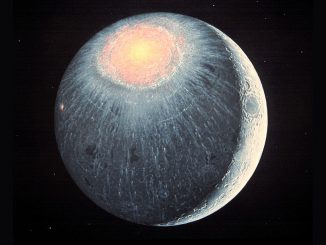
At the end of this month the Red Planet attains a maximum angular size of 24.3 arcseconds, when a telescope magnifying just 80× will enlarge it to the same size as the full Moon appears to the unaided eye. Note that Mars’ disc is 20 arcseconds or wider until 6 September this year. You can learn more about observing Mars by reading this article.

‘Fear’ and ‘terror’
Named after the mythological twin sons of the Greek god of war, Ares, Phobos (meaning fear) and Deimos (terror) were discovered by American Astronomer Asaph Hall just before the favourable Mars opposition of 1877 using the 26-inch refractor at the US Naval Observatory (USNO) in Washington, DC. He sighted outermost moon Deimos on 11 August and Phobos a week later.
We now know that potato-shaped Phobos is the larger of the two moons with dimensions of 27 × 22 × 18 kilometres, orbiting just 6,000 kilometres above the surface of Mars — closer to its parent planet than any other known moon — once every 7⅔ hours. Deimos has dimensions of 15 × 12 × 11 kilometres, orbiting Mars at an average distance of 23,460 kilometres every 30.3 hours.
Finding Phobos and Deimos
Given their diminutive size, the Martian moons are only accessible to large backyard telescopes when the Red Planet is particularly close. Around the end of July and early August 2018, Phobos glimmers at magnitude +11, while Deimos is a magnitude fainter at +12. Were it not for the searing glare and proximity of Mars — Phobos never gets further than 21½ arcseconds from the limb of Mars and 71.8 arcseconds for Deimos — the two moons would be comfortable targets in 15-cm (6-inch) aperture telescopes. At the last close opposition of Mars in 2003, several observers succeeded in glimpsing a moon in 20-cm (8-inch) instruments. At this opposition, you also have to factor in the glow from Earth’s waning gibbous Moon.
Since the disc of Mars is at least 800,000 times the brilliance of its faintest moon Deimos, the extreme challenge lies in spotting (or imaging) the faint specks of light amid the glare of their parent planet. Ideally, an unobstructed aperture telescope is your instrument of choice, since you wish to minimise diffraction (it’s easy to lose sight of a moon if its image falls on the diffraction spike of a Newtonian with a traditional secondary mirror support, for example), plus you need clean and collimated optics with quality eyepieces that are multi-coated to reduce light scatter. When looking for a moon at elongation, you may find it helpful to nudge the disc of Mars just outside the field of view.

In the accompanying illustration, time flows from the top down, with dates and Universal Times of events read from the scale on the left. The central grey column represents the disc of Mars, while the helical black and red lines are the paths of Phobos and Deimos, respectively. You can see that the interval between successive easterly or westerly elongations of Phobos is around 7⅔ hours, or 30.3 hours in the case of outer moon Deimos.
The graphic is orientated with north up and east to the left as Mars appears in the sky, hence observers with Newtonian/Dobsonian telescopes should rotate the illustration through 180° to match their eyepiece view, while users of refractors and catadioptrics (Schmidt- and Maksutov-Cassegrains) with a star diagonal need to mirror this graphic left-right to replicate what they see through the eyepiece.
For the benefit of UK-based observers, the horizontal green lines represent the dates and times that Mars is highest in the southern sky (i.e., transits) as seen from the heart of the British Isles (longitude 2.5° west). For example, consulting the diagram for 1 August around 1:40am BST (00:40 UT), you can see that Phobos lies close to eastern elongation and Deimos near western elongation; this is the event illustrated at the top of the page.
Given that Mars currently struggles to attain a peak altitude of 14 degrees around 1am BST as seen from the southern counties of England, observers in the UK are almost inevitably subject to sub-standard seeing and about a magnitude of atmospheric extinction (hence Phobos and Deimos would appear around magnitudes +12 and +13, respectively). An atmospheric dispersion filter will certainly help anyone having to view Mars at low altitudes.
For observers on the east coast of North America, favourable elongations of Phobos and Deimos occur near 5h UT, while elongations happening near 8h UT favour the west coast. For Australasian observers, Mars transits near the zenith in the northern sky and is visible throughout the long Southern Hemisphere winter nights. In New Zealand and Australia, optimal elongations of the Martian moons occur between 12h and 16h UT.
You can consult our interactive online Almanac to find the UT dates and times that Mars transits for any global location. Furthermore, if you prefer your data in tabular form, here are the dates and Universal Times of Phobos and Deimos elongation events until 10 August 2018:



